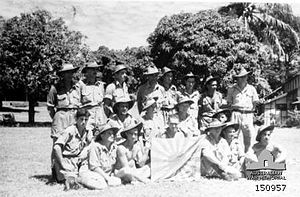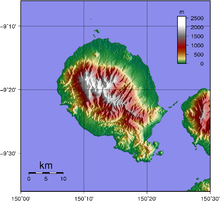- Battle of Goodenough Island
-
Battle of Goodenough Island Part of World War II, Pacific War, New Guinea campaign, 
Australian soldiers with a Japanese flag captured during the fighting at at Goodenough IslandDate 22–27 October 1942 Location Goodenough Island, Territory of Papua Result Australian victory Belligerents  Australia
Australia Empire of Japan
Empire of JapanCommanders and leaders Arthur Arnold
Keith GatewoodTsukioka Torashige Strength 640 353 Casualties and losses 13 killed, 19 wounded 39 killed, 15 wounded Rabaul (land battle) – Rabaul (1942 air raids) – Bougainville action – Salamaua-Lae Invasion – Mo – Coral Sea – Buna-Gona Invasion – Kokoda Track – Milne Bay – Buna–Gona – Goodenough Island – Wau – Bismarck Sea – I-Go – Salamaua-Lae campaign – Cartwheel – Wewak raids – Finisterres – Huon Peninsula – Bougainville – Rabaul (1943 air raids) – New Britain – Admiralties – Emirau – Take Ichi – Western New GuineaThe Battle of Goodenough Island (Operation Drake) was the Allied invasion of Goodenough Island, Papua during World War II, in the South West Pacific Area to deny the Imperial Japanese the ability to use the island prior to the Buna campaign.[1] The island was occupied by the Allies on 24 October 1942 after a short but heavy fight, with mopping up operations continuing until 27 October. The 2/12th Battalion was chosen as the unit to undertake the attack and was known as "Drake Force".[2]
Contents
Background
Goodenough Island situated just to the north east of Papua, between Buna and Milne Bay was strategically important for the upcoming Buna campaign and future campaigns in Papua, New Guinea and New Britain and construction of an airfield on the island would provide support those operations and provide protection to Milne Bay which was becoming a major staging and base area for the Allied forces. The island is roughly circular in shape, measuring 39 by 26 kilometres (24 by 16 mi) with an area of 687 square kilometres (265 sq mi) and a shoreline of 116 kilometres (72 mi). From a coastal belt varying in width from 2 to 10 kilometres (1.2 to 6.2 mi) in width, the island rises sharply to the summit of Mount Vineuo, 2,536 metres (8,320 ft) above sea level.[3]
A convoy of troops of 353 marines of 5th Sasebo Special Naval Landing Force supplemented by a few engineers of the 14th and 15th Pioneer Units (Setsueitai), led by Commander Tsukioka Torashige bound for Taupota and participation in the Battle of Milne Bay, was stranded on Goodenough Island on 25 August 1942. The motorized landing craft they were being transported in were destroyed while beached by P-40 Kittyhawks of the Royal Australian Air Force's No. 75 Squadron. After the failure of the Japanese to capture Milne Bay and the evacuation of the majority of those forces, the Japanese on Goodenough was now the largest un-subdued Japanese force close to Milne Bay.[4]
Final planning for the Buna campaign was underway and by October the offensive was underway and the attack on Buna was planned along a three-pronged attack on the Buna and Gona. One advance would pass close to Goodenough Island so General Douglas MacArthur decided to attack the island to guard the flanks of the main attack.[5]
Battle
The Australian army's 2/12th Battalion of the 18th Brigade, led by Lieutenant Colonel Arthur Arnold was selected to invade the island.[4] Boarding the Royal Australian Navy destroyers HMAS Stuart and HMAS Arunta on the 22 October, the troops were transported to Goodenough Island escorted by Task Force 44. Arriving at night of 22 October the battalion was landed on both sides of the island’s southern tip. Meanwhile, 60 Japanese troops were rescued by a submarine which also brought food and ammunition for the remaining 290 troops. It was planned to trap the Japanese troops between the two forces. A force of 520 troops of the 2/12th Battalion commanded by Arnold, landed at Mud Bay, while a smaller force of 120 men commanded by under Major Keith Gatewood, landed at Taleba Bay.[2][4]
The landing at Mud Bay had been observed by the Japanese and the Japanese set up defences and sent out patrols. In the morning of 23 October between 03:00 and 03:30 a small party of Japanese encroached the 2/12th Battalion's Mud Bay perimeter and gunfire was exchanged, with the body of a Japanese Warrant Officer found nearby. The force pushed toward Kilia from Mud Bay, however could make little progress at night due to the steep terrain and heavy rain. Sporadic enemy resistance and jungle slowed their progress and were still a mile away from Kilia on 24 October.[2]
The 2/12 Battalion landing at Taleba Bay took a Japanese machine-gun position at about 06:00. Two platoons were sent south and were engaged by Japanese forces.[2] The Japanese were driven beyond Niubulu Creek, however a heavy Japanese counterattack from the north at 09:00 caused casualties amongst the Australians and almost caused the force to be cut off between two Japanese forces and withdrew from the area. Suffered six killed, ten wounded and three missing the force continued to fall back pursued by the Japanese and came under mortar and machine-gun fire. Without communications a runner was sent to the force commanded by Arnold, however faced with being overrun Gatewood withdrew the force to Taleba Bay and was transported to Mud Bay aboard HMAS Stuart.[2]
On the 24 October, the Japanese radioed Rabaul stating that the attack had been repulsed and inflicted heavy casualties and also stated that they had suffered seventeen killed or wounded, including Tsukioka. Arnold launched an attack on Kilia at 09:10 hours, however was not able to take the village.[2][4] Japanese air support provided reconnaissance of the Australian positions and Zeros strafed the Australian positions near Mud Bay as well as the ketch McLaren King in Mud Bay, which had wounded onboard and further casualties were caused.[2]
With the Australian forces not able to move forward, the Japanese withdrew and were transported to Fergusson Island with their equipment and supplies on two motorized landing craft and a punt, arriving at dawn on the 25 October on Fergusson Island, where they were later collected by the cruiser Tenryū and the submarine I-1.[4] The 2/12th Battalion advanced from Kilia to Galaiwai Bay, meeting no resistance and only encountered a number of Japanese fleeing into the jungle.[2] The remaining Japanese defenders were mopped up and the island declared secured by 27 October.
Aftermath
Australian losses were 13 killed and 19 wounded. The Japanese had suffered 39 killed, with 20 killed and 15 wounded during the battle and the others were troops left behind and others killed in action prior to the Australian landing.[2] Of those behind two Japanese died of disease months later and Shigeki Yokota was taken prisoner in July 1943.[4] The attack by the 2/12th had not worked to plan, with the Japanese fighting until being able to be evacuated. The 2/12th Battalion remained on the island until the end of December, eventually being shipped to Oro Bay on the night of 28–29 December, joining the attack on Buna on 31 December.[2]
Due to the strategic importance of the island for the forthcoming operations against the Imperial Japanese forces in the South West Pacific Area, the small Australian occupation force used deception and camouflage to make the Japanese believe that a brigade-sized force was occupying the island. They fabricated dummy structures including a hospital, anti-aircraft guns constructed of simple logs pointed at the sky, and barricades of jungle vines which looked like barbed wire. They also lit fires to appear as cooking fires for large numbers of soldiers, and sent messages consistent with what a brigade of soldiers would be expected to send. The force was able to keep the Japanese at bay until reinforcements arrived. The mission airstrip on the island at Vivigani, was developed into Vivigani Airfield, an airfield for Australian and American aircraft. The island became a staging point and supply base for operations in New Guinea and New Britain.
Order of battle
Allied Forces
Ground Forces
- 2/12th Battalion[2]
- 2/5th Field Ambulance
- No. 2 Anti-aircraft Platoon
- Detachment J, Section Signals, 7th Division
- Transport Platoon
- Detachment Mortars
- Detachment Australian Army Service Corps
- Captain Burkholder (United States Army Service of Supply, New Guinea)
- Lieutenant Humphrey (8th Fighter Group, United States Army Air Forces)
- Task Force 44 (Covering Force)
- Cruiser
- USS Phoenix (flagship)
- Destroyers
- Cruiser
- Transport Force
- HMAS Arunta
- HMAS Stuart
- Ketch Matona
- Ketch McLaren King
- Ketch Tierno
- 3 captured Japanese barges
- 2 power driven whale boats
Japanese Forces
- 5th Sasebo Special Naval Landing Force
- detachment 14th Pioneer Unit
- detachment 15th Pioneer Unit
Notes
- ^ Macarthur (1994), p.75
- ^ a b c d e f g h i j k 2/12th Battalion war diary
- ^ "Goodenough Island Geography". 2009. http://www.oceandots.com/pacific/png/goodenough.php. Retrieved 2009-12-08.
- ^ a b c d e f "Dunn (2003)". 2009. http://www.j-aircraft.com/research/rdunn/murakami/murakami.htm. Retrieved 2009-12-08.
- ^ "Battle of Goodenough Island". 2009. http://www.historyofwar.org/articles/battles_goodenough_island.html. Retrieved 2009-12-08.
References
- Reports of General MacArthur: Campaigns of MacArthur in the Pacific, Vol 1. General Staff. Washington, D.C.: Center of Military History, United States Army, reprint 1994.
- Bullard, Steven (translator) (2007). Japanese army operations in the South Pacific Area New Britain and Papua campaigns, 1942–43. Canberra: Australian War Memorial. ISBN 9780975190487. http://ajrp.awm.gov.au/ajrp/ajrp2.nsf/088031725e4569e4ca256f4f00126373/1fcb61d633972daaca257291000abf44?OpenDocument.
- Collie, Craig; Marutani, Hajime (2009). The Path of Infinite Sorrow. The Japanese on the Kokoda Track. Crows Nest: Allen & Unwin. ISBN 9781741758399.
- Gillison, Douglas (1962). Royal Australian Air Force 1939–1942. Australia in the War of 1939–1945. Series 3 – Air. Canberra: Australian War Memorial. http://www.awm.gov.au/histories/second_world_war/volume.asp?levelID=67912.
- McCarthy, Dudley (1959). South-West Pacific Area—First Year: Kokoda to Wau. Australia in the War of 1939–45, Series 1 – Army, Volume V. Canberra: Australian War Memorial. OCLC 3134247. http://www.awm.gov.au/histories/second_world_war/volume.asp?levelID=67907.
- Milner, Samuel (1957). Victory in Papua. United States Army in World War II: The War in the Pacific. Washington DC: Office of the Chief of Military History, Department of the Army. http://www.ibiblio.org/hyperwar/USA/USA-P-Papua/.
Categories:- Conflicts in 1942
- 1942 in Papua New Guinea
- South West Pacific theatre of World War II
- Battles of World War II involving Australia
- Battles of World War II involving Japan
- Battles and operations of World War II involving Papua New Guinea
Wikimedia Foundation. 2010.

